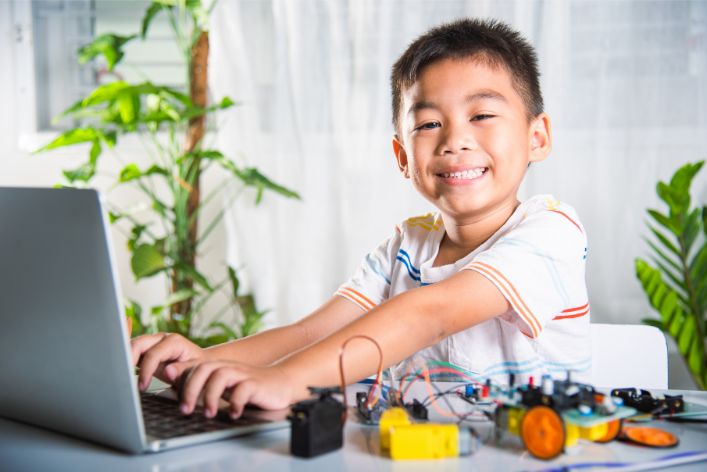Last Updated on May 2, 2023

Technology has transformed almost every aspect of our lives, and education is no exception. From online learning platforms to interactive whiteboards and educational apps, students are experiencing how EdTech is changing the face of education.
But what is the impact of these technological advancements on students? How is EdTech empowering learners and transforming the way they learn? In this article, we will explore the benefits of EdTech, share examples of how it is being used in classrooms around the world, and examine the impact it is having on teaching and learning.
We will also discuss the challenges and risks associated with EdTech and provide best practices for integrating it into the classroom responsibly and effectively. By the end of this article, you will have a better understanding of how EdTech is empowering students and the potential it has to transform education for generations to come.
The Benefits of EdTech
Technology has brought about immense change in almost every sphere of life, and education is no exception. EdTech, or educational technology, refers to the use of technology to enhance and transform the learning process. There are numerous benefits to incorporating EdTech into the classroom.
Firstly, EdTech can increase student engagement by providing interactive and engaging learning experiences that capture students’ attention. The use of digital media, virtual and augmented reality, and other tools can create a more dynamic and immersive learning experience.
Secondly, EdTech allows for personalized learning experiences that cater to individual student needs and learning styles. Technology can provide assessments and feedback that adapt to the student’s abilities and personalized learning paths that cater to their interests and strengths.
Thirdly, EdTech can improve accessibility and inclusivity by providing learning tools that cater to different abilities and needs, such as text-to-speech software for students with reading difficulties.
Fourthly, EdTech provides opportunities for real-world application of skills, allowing students to engage in problem-solving, critical thinking, and decision-making activities that simulate real-life situations.
Fifthly, EdTech enhances collaboration and communication among students and teachers, facilitating teamwork and collective problem-solving. This leads to the development of important social skills and the ability to work effectively in groups.
Finally, EdTech saves time for teachers by automating administrative tasks such as grading, record-keeping, and lesson planning. This frees up more time for them to focus on their students and provide personalized support.
Overall, EdTech has numerous benefits that enhance the learning experience for students and transform the way they interact with the material.
Examples of EdTech in Action
EdTech has revolutionized the traditional classroom by incorporating digital tools and technology to enhance and transform the learning experience. There are numerous examples of EdTech in action that have become increasingly popular in classrooms around the world.
Online learning platforms are one of the most common forms of EdTech, providing students with access to interactive and engaging online courses, tutorials, and multimedia resources. Platforms like Khan Academy, Coursera, and Udemy offer online courses and resources that cater to a wide range of topics and subject areas.
Virtual and augmented reality (VR/AR) is another form of EdTech that is gaining popularity. VR and AR can provide immersive and interactive learning experiences that simulate real-world situations, allowing students to apply their learning more practically and engagingly. For example, VR and AR can be used to simulate scientific experiments or historical events, providing students with a more vivid and memorable learning experience.
Interactive whiteboards have also become a popular tool in the classroom. These digital boards allow teachers to create interactive and engaging lessons that incorporate multimedia resources, such as videos, animations, and images, to enhance the learning experience.
Educational apps are another example of EdTech that has become increasingly popular. Apps such as Duolingo and Rosetta Stone provide language-learning resources that are engaging, interactive, and personalized to the user’s level and learning style.
Social media and digital communication tools have also been incorporated into the classroom as a means of communication and collaboration. Tools like Slack and Google Classroom allow teachers and students to share resources, collaborate on assignments, and communicate more effectively.
Are There Impacts on Teaching and Learning?
The impact of EdTech on teaching and learning has been significant, as it has transformed the traditional classroom into a more dynamic, engaging, and personalized learning environment. EdTech has had a positive impact on both teachers and students, with many benefits and opportunities for growth.
EdTech has had a significant impact on teaching, allowing teachers to create interactive and engaging lessons that cater to individual student needs and learning styles. With digital tools and multimedia resources, teachers can create personalized learning experiences that allow students to learn at their own pace and in their own way. Teachers can also track student progress and provide feedback in real time, allowing for immediate adjustment and improvement.
EdTech has also had a significant impact on student learning, providing a more dynamic and immersive learning experience that captures their attention and fosters engagement. With EdTech, students can access a wealth of information and resources that cater to their individual interests and learning styles. They can also engage in interactive and collaborative activities that foster teamwork, problem-solving, and critical thinking skills.
In addition, EdTech has transformed assessment and evaluation, allowing for a more accurate and comprehensive assessment of student progress. With digital tools, teachers can provide assessments and feedback that cater to individual student needs and abilities and track progress over time to identify areas of strength and weakness.
To sum it up, the impact of EdTech on teaching and learning has been positive, providing opportunities for growth, engagement, and personalization. With the integration of EdTech into the classroom, educators can provide a more effective and comprehensive learning experience that prepares students for success in the modern world.
Challenges and Risks
While EdTech has numerous benefits and opportunities for growth, it also poses certain challenges and risks that must be addressed. These include issues of equity, access, privacy, and security.
One of the main challenges of EdTech is ensuring that it is accessible to all students, regardless of their socioeconomic background. There is a risk that EdTech could widen the gap between students who have access to technology and those who do not, creating a digital divide that further exacerbates existing educational inequalities.
Another challenge is ensuring that student data and privacy are protected. As EdTech collects and stores large amounts of data on student performance and behavior, there is a risk that this data could be used in ways that compromise student privacy and security.
There is also a risk of over-reliance on technology, with some educators relying too heavily on digital tools and losing sight of the importance of face-to-face interaction and personal connections in the learning process. Additionally, there is a risk of replacing human expertise with algorithms, which could lead to a loss of creativity, critical thinking, and problem-solving skills among students.
Finally, there is the challenge of keeping up with the rapid pace of technological change, as new digital tools and technologies are constantly being developed and introduced. It can be difficult for educators to keep pace with these changes and ensure that their students are adequately prepared for the modern world.
Best Practices for Integrating EdTech into the Classroom
Integrating EdTech into the classroom requires careful planning, preparation, and implementation. To ensure that EdTech is used effectively, educators must follow best practices that promote engagement, accessibility, and student-centered learning. Here are some best practices for integrating EdTech into the classroom:
1. Start with a clear vision: Educators should have a clear understanding of how they want to use EdTech in the classroom and what outcomes they hope to achieve. This will help them choose the right tools and resources and create an implementation plan.
2. Choose the right tools: Educators should choose EdTech tools and resources that align with their instructional goals and student needs. This may involve researching and testing different options to find the ones that work best for their classroom.
3. Provide professional development: Educators should receive adequate training and professional development to ensure that they are proficient in using EdTech tools and resources. This will help them use technology effectively and provide students with the support they need.
4. Foster a student-centered approach: Educators should use EdTech tools and resources to promote student-centered learning, where students are actively engaged and encouraged to take ownership of their learning.
5. Ensure accessibility: Educators should ensure that all students have access to the technology and resources they need to succeed. This may involve providing access to devices, software, and online resources, as well as ensuring that students with disabilities are accommodated.
6. Monitor progress: Educators should monitor student progress and adjust their use of EdTech tools and resources as needed. This will help them identify areas where students may be struggling and make adjustments to ensure that all students are supported.
By following these best practices, educators can integrate EdTech into the classroom in a way that promotes engagement, accessibility, and student-centered learning.
Conclusion
Responsible implementation and use of EdTech are crucial to ensuring that technology is used effectively and does not have unintended negative consequences. This involves considering issues such as privacy, security, equity, and accessibility to ensure that all students can benefit from technology without being put at risk.
Educators must take an active role in ensuring that technology is used responsibly and ethically in the classroom. This includes monitoring student progress, ensuring that data is handled securely and responsibly, and making sure that technology is used to enhance, rather than replace, human expertise.
Moreover, responsible implementation and use of EdTech must be an ongoing process that involves continuous evaluation and adaptation. This means that educators must regularly assess the impact of technology on student learning and adjust their use of technology accordingly.
Evaluation and adaptation are important because technology is constantly evolving, and what may have been effective yesterday may not be effective tomorrow. By continually evaluating and adapting their use of EdTech, educators can ensure that they are using technology in a way that is aligned with the changing needs of their students and the broader educational landscape.
Additionally, ongoing evaluation and adaptation ensure that technology is being used in a way that promotes equity and access for all students. This may involve making adjustments to ensure that technology is accessible to all students, regardless of their socioeconomic background or disability status.
Ultimately, responsible implementation and use of EdTech are critical to ensure that technology is used effectively and ethically in the classroom. By continuously evaluating and adapting their use of technology, educators can ensure that they are using technology to enhance, rather than replace, human expertise and provide all students with an equitable and personalized learning experience.
Before you go…
Hey, thank you for reading this blog to the end. I hope it was helpful. Let me tell you a little bit about Nicholas Idoko Technologies. We help businesses and companies build an online presence by developing web, mobile, desktop, and blockchain applications.
We also help aspiring software developers and programmers learn the skills they need to have a successful career. Take your first step to becoming a programming boss by joining our Learn To Code academy today!
Be sure to contact us if you need more information or have any questions! We are readily available.











